Transforming your yard into a vibrant oasis starts with smart planning. Whether you’re working with raised beds or open ground, blending annuals and perennials creates year-round color that evolves with the seasons. Imagine bright tulips in spring, followed by summer-blooming phlox and verbena, then autumn’s golden achillea – all working together to paint your landscape.
Successful designs balance aesthetics with practicality. Mix self-seeding favorites like calendula or cornflowers with structured bulbs such as alliums for effortless charm. Focus on layering heights and coordinating hues to guide the eye naturally through your space. These techniques help even small areas feel thoughtfully composed.
Your local conditions play a crucial role. Assess sunlight patterns and soil quality before choosing plants – drought-tolerant options thrive in sunny spots, while shade-loving varieties add depth to darker corners. For more inspiration on blending function with style, explore our guide to elevating your outdoor space through intentional design choices.
By combining smart plant selection with creative arrangements, you’ll craft an environment that delights the senses while requiring minimal upkeep. The result? A personalized retreat that grows more captivating each year.
Introduction: Transforming Your Outdoor Space with Flower Garden Layout Ideas
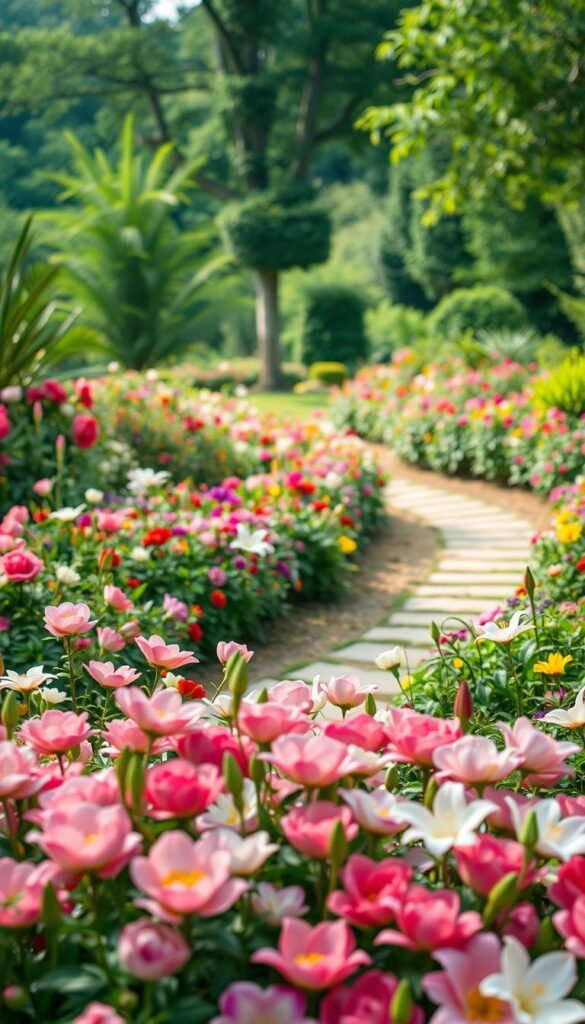
Your home’s curb appeal gets a major boost when you master the art of strategic flower bed placement. Front yard designs range from neat bordered areas to elevated planters that frame entryways. These living displays become natural welcome mats, blending seasonal colors with your home’s architecture.
Smart layouts do more than look pretty—they solve practical challenges. Curved edges can soften angular patios, while rectangular beds create clean lines along walkways. As landscape designer Julie Moir Messervy notes:
“Great spaces feel discovered, not imposed.”
This philosophy helps your plantings feel like natural extensions of the environment.
| Bed Type | Best For | Maintenance Level | Visual Impact |
|---|---|---|---|
| Raised | Controlled soil conditions | Medium | Architectural focus |
| Bordered | Traditional landscapes | Low | Defined edges |
| Integrated | Naturalistic designs | Variable | Seamless blending |
Through creative gardening ideas, you can turn overlooked corners into blooming showcases. Mix perennials like coneflowers with annual accents for changing textures. This approach supports pollinators while keeping your space lively from spring frost to autumn’s first chill.
Consider how different zones create outdoor “rooms”—a sunny butterfly area here, a shaded fern nook there. Proper spacing reduces disease risk, and companion planting naturally deters pests. Your landscape becomes both beautiful and functional, needing less work over time.
Choosing the Perfect Flower Bed Style for Your Space
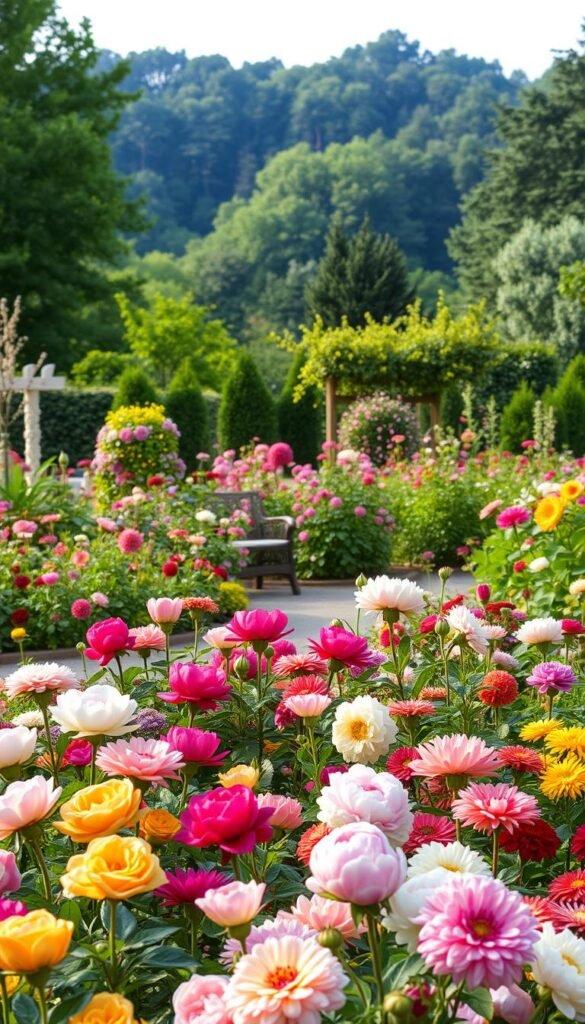
Your outdoor space becomes an extension of your home’s personality through intentional bed designs. Let’s explore options that balance practicality with visual charm.
Exploring Different Garden Bed Types
Raised beds solve drainage issues while adding vertical interest. They’re ideal for urban spaces or clay-heavy soil. Build them from cedar or stone for lasting appeal.
Cottage-style arrangements mix lavender, sage, and cosmos in casual clusters. These beds attract pollinators while hiding veggie patches among blooms. The secret? Plant taller species at the back for layered depth.
Formal designs thrive on symmetry. Try boxwood hedges framing identical plant groups. Geometric shapes like circles or diamonds work best near patios or entryways.
Matching Styles to Your Home’s Aesthetic
Modern ranch houses shine with clean-lined border beds. Use ornamental grasses and succulents in repeating patterns. For Victorian homes, curved island beds overflowing with peonies create timeless elegance.
- Southwestern architecture: Pair xeriscaped beds with agave and yucca
- Farmhouse charm: Rustic raised beds with trailing nasturtiums
- Contemporary spaces: Tiered concrete planters with architectural ferns
Remember scale – a sprawling cottage bed might overwhelm a compact bungalow. Test bed shapes using garden hoses before digging. This trick helps visualize proportions without commitment.
Essential Tools and Preparation for a Successful Garden Layout
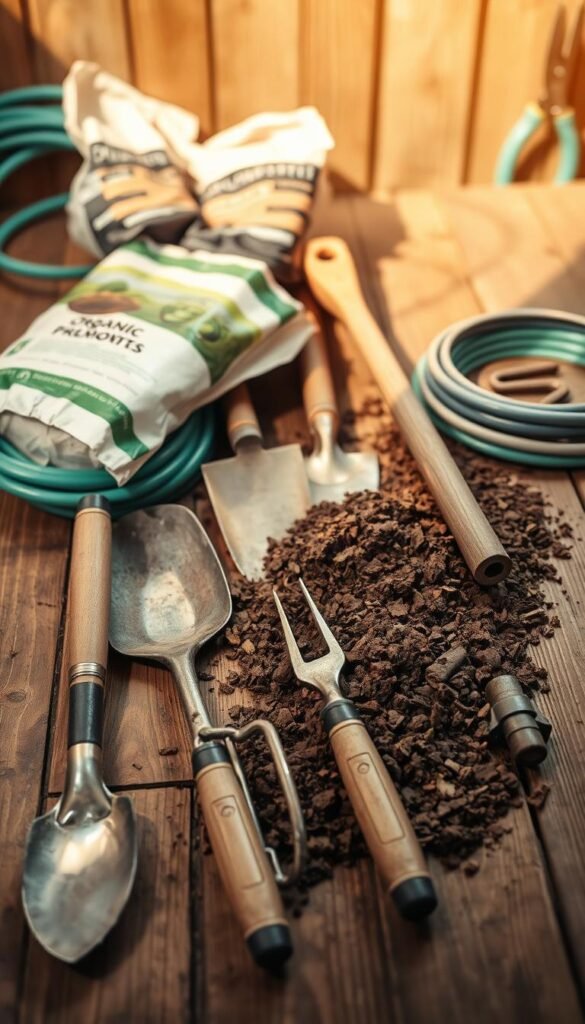
Healthy soil forms the foundation of every thriving outdoor space. Before choosing plants, test your earth’s texture and pH using an affordable kit from local nurseries. This simple step reveals whether you’re working with dense clay, quick-draining sand, or ideal loam.
Soil, Drainage, and Plant Health
Mediterranean herbs like rosemary thrive in gritty conditions, while black-eyed Susans adapt to heavy clay. Improve your soil structure by mixing 3 inches of compost into planting zones. This boosts nutrients and creates air pockets for roots to spread.
For areas with standing water, consider these solutions:
- Install French drains using perforated pipes
- Build raised beds 12-18 inches high
- Add coarse sand to clay-heavy zones
| Soil Type | Best Amendment | Drainage Impact |
|---|---|---|
| Clay | Compost + Sand | Improves by 40% |
| Sandy | Peat Moss | Holds 30% more water |
| Loamy | Leaf Mold | Maintains balance |
Planning Your Layout with Simple Techniques
Use garden hoses to map curved plant beds, or stakes for geometric shapes. Leave 18-inch paths between growing areas for easy access. Time your prep work – amend soil 4 weeks before spring planting for optimal results.
Essential tools for success:
- Soil pH tester ($12-$25)
- Sharp spade for edging
- Measuring wheel for spacing
Flower Garden Layout Ideas: Arranging Beds and Borders for Visual Impact
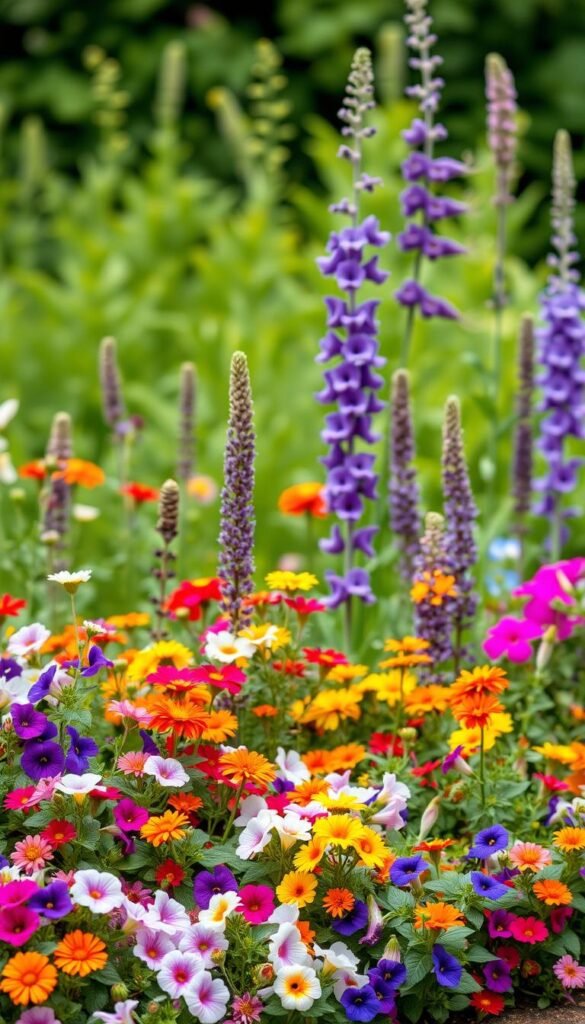
Blending structured beds with flowing borders creates rhythm in your landscape. The magic happens when you balance formal elements with natural curves, guiding the eye through dynamic compositions. Let’s explore professional techniques that make different areas feel connected.
Mastering Layered Plant Placement
Start by positioning tall specimens like hollyhocks at the back of your flower bed. Mid-height bloomers such as salvia fill the middle layer, while creeping thyme spills over edges. This tiered approach ensures every plant contributes to the display.
Odd-number groupings work wonders. Cluster five coneflowers or seven black-eyed Susans for organic appeal. Landscape designer Mark Dwyer explains:
“Groupings of three or five create rhythm without appearing contrived.”
| Ground Cover | Height | Bloom Color | Sun Needs |
|---|---|---|---|
| Mexican Fleabane | 3-6″ | White/Pink | Full Sun |
| Aubrietia ‘Purple Cascade’ | 4″ | Violet | Partial Sun |
| Sedum ‘Angelina’ | 6″ | Yellow | Full Sun |
Soft edges make spaces feel larger. Let creeping phlox cascade over stone walls or allow sweet alyssum to blur path boundaries. These touches help different zones flow together naturally.
Repeat key colors every 10-15 feet to maintain visual continuity. Pair spiky lupines with mounded hostas, then echo their purple tones in border asters. This approach builds cohesion while keeping the look engaging through seasons.
Incorporating Elements for Year-Round Interest and Impact
Keep your outdoor space alive with movement and texture through every weather shift. Smart plant choices create evolving displays that captivate in snowstorms and summer heat alike.
Building Your Four-Season Framework
Start with perennials that pull double duty. Ornamental grasses like Panicum ‘Northwind’ offer feathery plumes in August, golden stems in December, and fresh blades by April. Pair them with compact Mahonia shrubs for winter berries and spring blooms.
Follow this seasonal roadmap:
- Early year: Snowdrops push through frost, followed by crocus clusters
- Summer peaks: Daylilies and coneflowers thrive with minimal watering
- Autumn drama: Cotinus shrubs explode in crimson foliage
| Plant | Seasons Active | Key Features |
|---|---|---|
| Anemone ‘Honorine Jobert’ | Late summer-fall | White blooms, drought-tolerant |
| Nandina ‘Fire Power’ | Year-round | Evergreen, winter berry display |
| Allium ‘Purple Sensation’ | Spring-summer | Deer-resistant, pollinator favorite |
For patios or small areas, try colorful container gardening with dwarf evergreens and seasonal bulbs. This approach lets you rotate plants easily as temperatures change.
Prioritize climate-resilient varieties like Russian sage or sedum. These survivors handle erratic rainfall while keeping your landscape vibrant. As horticulturist David Culp advises:
“Let plants work in shifts – when one finishes blooming, another takes center stage.”
Creating Focal Points with Edging and Border Designs
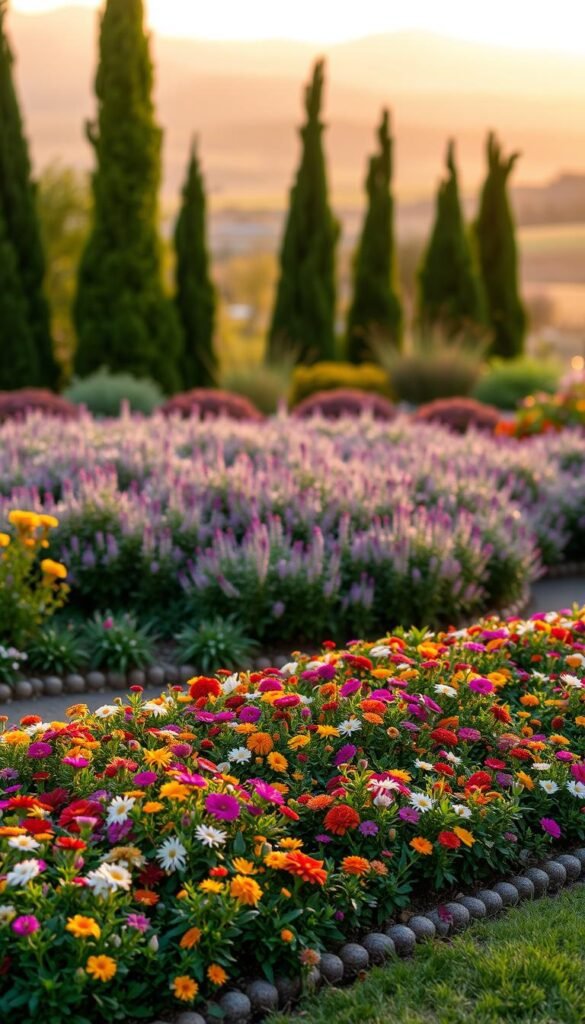
Define your outdoor personality through creative edge treatments that frame your favorite blooms. Thoughtful borders guide the eye while preventing soil erosion and weed spread. Let’s explore materials that blend sustainability with striking visual effects.
Using Natural and Sustainable Materials
Woven willow branches create rustic charm for casual flower beds. These biodegradable edges last 2-3 seasons and enrich soil as they decompose. For vintage appeal, try reclaimed bricks arranged in zigzag patterns – their weathered surfaces tell stories of past buildings.
Consider these eco-friendly options:
| Material | Lifespan | Best For | Maintenance |
|---|---|---|---|
| Terracotta tiles | 10+ years | Formal areas | Annual cleaning |
| Weathered stone | Lifetime | Sloped beds | None |
| Log sections | 3-5 years | Woodland areas | Replace rotting pieces |
Enhancing Visual Appeal with Decorative Elements
Fragrant lavender varieties like ‘Arctic Snow’ make living borders that release calming scents when brushed. For modern designs, try powder-coated steel strips that create crisp lines. These metal edges pair well with budget-friendly raised beds in urban spaces.
Add personality with:
- Salvaged garden tools as vertical accents
- Mosaic stepping stones through planting areas
- Driftwood sculptures that double as insect hotels
Landscape architect Julie Moir Messervy advises:
“Edging should whisper ‘come closer’ rather than shout ‘keep out’.”
Follow this philosophy by softening stone borders with creeping thyme or letting sweet alyssum spill over tile edges.
Integrating Raised Beds and Garden Containers for Versatility
Elevate your growing potential by combining structured flower beds with movable containers. This dynamic duo lets you adapt to challenging spaces while showcasing your favorite plants at perfect heights.
Why Raised Solutions Shine
Raised beds give you command over soil quality and drainage. They warm faster in spring, extending your growing season. Build them waist-high to reduce back strain, or go low-profile for creeping ground covers.
Containers add flexibility where traditional planting won’t work. Try strawberries in hanging pots or dwarf sunflowers on balconies. Rotate them seasonally to highlight blooming stars.
Both options help manage tricky areas:
• Slopes become terraced displays
• Patios transform into lush retreats
• Poor native earth gets bypassed entirely
Mix materials for visual harmony – weathered wood beds paired with galvanized steel planters create rustic-modern appeal. Remember to match container sizes to your plants’ mature roots for thriving results.






